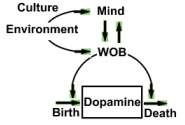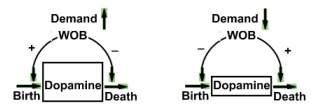
 |
First
Concepts.
WOB
is Optimal
Medicine tells us that Parkinson's disease (PD) is a neurological
syndrome resulting from a damage (necrosis) of the basal ganglia (substantia
nigra) in the brain, initiating a deficiency of the neurotransmitter dopamine.
PD is initiated by a shortage of dopamine, and ought therefore be treated by dopamine replacement, with an analog called levodopa.
Medicine has only one therapeutic
objective, dopamine replacement. Otherwise she has
little to offer . A simplistic
approach to an intricate disease. Medicine ignores the main therapeutic objective,
which is to slow down disease progression! It will be illustrated here with the aid of a simple model.
WOB controls dopamine production
which is driven by a demand
by environment and mind (culture).
 |
 |
During prolonged diminished activity WOB reduces muscle mass
(hypotrophy), and dopamine demand declines. Superfluous neurons die, death rate rises, birth rate declines,
and cell pool shrinks (hypoplasia),
When production meets the new demand, birth rate equals death rate
WOB controls all processes and adjusts them to meet the demand
of the organism, constrained by environment and mind. When it gets cold WOB
turns the heat on , and vice versa.
WOB responds also to the mind, which receives signals
and directives from society (culture). The adjustment of processes at any instant is called WOB
solution. It is always the most
optimal solution in the given circumstances.
Injury destroys cells (necrosis), death rate rises, and production
declines. WOB lets the remaining cells live longer, so that their death rate
declines. As long as demand for dopamine is not met, new cells are formed, birth
rate rises, cell pool increases,
and production rises. Once production meets the requirements of the body,
birth rate equals death rate and cell pool does not change.
Chronic injury
The main causes of chronic injury are infection and reduced blood flow (ischemia due to arteriosclerosis), like in elderly individuals and diabetics. Initially WOB responds like in acute injury, yet the outcome depends on the relationship between cell birth and death. Ischemia kills cells and so raises death rate. WOB may raise birth rate to a certain extent, however it cannot replenish an extensive cell loss and dopamine production declines. It has to be stressed that even in chronic damage new cells are formed, however birth rate does not cope with death rate.
1. Full compensation,
when cell birth and death rates are high and equal.
2. Decompensation, when cell
birth and death rates are high and death rate exceeds birth rate.
3. Total dopamine loss (aplasia) when no cells are formed.
Decompensation is manifested clinically as Parkinson’s
disease. Total dopamine loss (aplasia) results in dyskinesia.
When less dopamine is produced than the body needs, WOB initiates
a slight tremor. Tremor is neither
a pathology nor a disease. It is the most
optimal solution which
WOB arrived at. At this stage, when patient sleeps and
mind stops bogging WOB down, tremor
disappears. A sleeping motor system
needs less dopamine.
Tremor is also a WOB message to the mind as if saying: "My dopamine reserves are slightly depleted, cut down your motor activity otherwise I shall have to respond with tremor". Yet mind does not want to yield. Social responsibilities demand that business be as usual, and mind takes levodopa Since demand for dopamine is met tremor disappears. The external supplement reduces the demand for internal dopamine production. Cell death rises, cell birth declines, and cell pool also declines. The price for tremor removal is a decline of internal dopamine production.
As chronic injury proceeds dopamine cell pool declines. Since
getting levodopa, cell birth is smaller than in an untreated patient. Internal dopamine
reserve is smaller than that of a healthy patient. Since PD is an ongoing decline
of dopamine reserves, levodopa speeds PD progression to the state of dyskinesia.
What WOB regards as an
optimal solution, may not meet the patient’s expectation. He (mind)
demands a good life, and gets from
his doctor the desired pill. However
levodopa has a disadvantage which cannot be ignored. Since suppressing internal dopamine production
internal dopamine reserve declines. On the other hand levodopa effectiveness depends on internal
dopamine reserves. As they dwindle so does levodopa effect. In other words,
levodopa speeds PD progression
and should be taken with a great
care. Physician’s task is to work out a compromise between WOB
solution and mind demand for a better life.
We have to distinguish between two aspects of PD. A declining production which is handled by WOB, and
called WOB-PD, and a demand for a better life, called Mind-PD. Physician
can do little to assist WOB which knows best how to handle
declining resource. His main task is to assist the mind. Social and cultural
pressure on the patient increases her misery, which has nothing to do with the chronic injury from which she suffers. Her misery is product of the
mind , or Mind-PD, which ought
to be the main concern of the physician.
First he ought to turn his attention to patients whose PD progresses
slowly. They know how to live with PD in good health, and are called here PD-yogis.
What is their secret and how to apply it to other patients?
It is striking that during sleep tremor vanishes, which indicates that WOB manages well without assistance. One wonders what other
conditions may enable the patient (WOB) to reduce tremor?
A meditating patient
may attain a sleep like condition while maintaining his full consciousness.
His muscles relax, heart beats slower, and
so is breathing. Dopamine
demand declines, and tremor vanishes. Meditation has yet another advantage.
Patient learns how to ignore his mind with all this noise generated by society
and culture. Meditation reduces the demand for dopamine. It introduces the patient to a new life. From now on his
mission is to be a PD-Yogi.
Is risky, however has many advantages. Body building is not desired since it increases dopamine demand. Aerobic exercises may be very helpful, since organism learns how to conserve oxygen and utilize less dopamine. Aerobics improve blood circulation, and may alleviate local ischemia which kills neurons and depletes dopamine.
PlaceboIs effective for treating Mind-PD.
When patient demands levodopa treatment at all cost, he may benefit from interleaving placebo pills between the real stuff (v. Placebo)
When a muscle is activated, brain neurons controlling it get
more blood. When I laugh neurons controlling my laughter get more blood . One
wonders whether it might be possible to divert blood to neurons controlling
facial muscles by activating other muscles? This might be achieved with Tai Chi and Chi Gong.
Chinese Mind-Body Exercises.
Ancient Chinese martial arts, Tai
Chi, and Chi Gong help improve balance, strength and body awareness. Tai
Chi is described as meditation in movement using controlled breathing
combined with a slow and precise flow of body postures. Chi Gong,
is described as meditation in stillness during which participants learn to better
control their movements through directed visualization (imagery), meditation
and controlled breathing.
Like sport these exercises are risky
and the patient has to be closely monitored. They may be applied to bolster
a 'Slow is chic' attitude. Thai Chi is like in a slow dance. It gradually activates different
muscles. One wonders what might be the choreography which enhances blood flow in neurons controlling facial muscles,
enabling the patient to laugh again.
Terra incognita
These examples illustrate the vast
treatment potential of the so called alternative medicine, which ought to be examined scientifically. How to evaluate effectiveness of these treatments? Two
indicators might suffice: Whether they reduce tremor or rigidity, and whether
patient feels better.